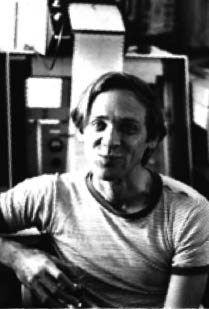Donald C. Backer
Donald Charles Backer (born November 9, 1943 in Plainfield , New Jersey , † July 25, 2010 in Berkeley , California , also known as Don Backer ) was an American astrophysicist and specialist in the field of radio astronomy . He became known in specialist circles for his contributions to the understanding of pulsars and black holes, and in particular for discovering the first millisecond pulsar . Since 1989 he has been Professor of Astronomy at the University of California, Berkeley .
research
Don Backer grew up in New Jersey and received his Bachelor -degree 1966 at the Department of Technical Physics ( engineering physics ) at the Cornell University in New York . He then moved to the University of Manchester , where he obtained his master's degree in radio astronomy in 1968 . He then returned to Cornell University, where he graduated in 1971 with a doctorate in astronomy. This was followed by postdoc at the National Radio Astronomy Observatory and at the Goddard Space Flight Center , from 1975 until his death in the Astronomy Department of the University of California, Berkeley, in particular at the Radio Astronomy Laboratory .
In 1989 Backer was appointed professor of astronomy, and from 2008 he also headed the Radio Astronomy Laboratory . An obituary from Berkeley University stated: "His research focused on pulsars, high-energy astrophysics, the era of reionization and exploring these topics with the most ingenious and modern instruments." For example, Backer developed digital systems with their help Pulsars can be discovered and precisely measured, systems that are now considered the standard in their field.
Don Backer was a pioneer in the field of Very Long Baseline Interferometry . His most significant success is his contribution to the discovery of the first millisecond pulsar at the Arecibo Observatory in 1982. This astronomical object was already known as radio source 4C21.53 , but other researchers had ignored some of its unusual properties, while Backer believed it possible to associate them with the properties of a pulsar. From the fact that other astronomers had not detected any pulses, he concluded that they were not detectable with the standard methods. He changed the measuring method in such a way that he was able to register ever shorter pulses - and in fact he finally identified the object 4C21.53 as a neutron star with a rotation time of only 1.5578 milliseconds, named as a pulsar PSR 1937 + 21 . An obituary in the journal Nature stated: "This discovery of a new class of stars rotating around their axis thousands of times per second was a sensation."
literature
- James Moran: Donald Charles Backer. In: Physics Today. Volume 64, No. 7, p. 61, 2011. doi: 10.1063 / PT.3.1174 , full text
Individual evidence
- ↑ Donald C. Backer, Shrinivas R. Kulkarni , Carl E. Heiles , Michael M. Davis and W. Miller Goss: A millisecond pulsar. In: Nature . Volume 300, 1982, pp. 615-618, doi: 10.1038 / 300615a0 .
- ↑ Short biography on the server of the University of Berkeley ( Memento from June 9, 2010 in the Internet Archive )
- ↑ World-renowned astronomer Donald C. Backer dies at age 66. Obituary on berkeley.edu of July 28, 2010.
- ^ In Memoriam Donald C. Backer, Professor of Astronomy, UC Berkeley, 1943-2010. At: universityofcalifornia.edu , last accessed on July 28, 2020.
- ↑ Shrinivas R. Kulkarni: Donald Charles Backer (1943-2010). In: Nature. Volume 467, 2010, p. 41, doi: 10.1038 / 467041a , full text .
| personal data | |
|---|---|
| SURNAME | Backer, Donald C. |
| ALTERNATIVE NAMES | Backer, Donald Charles; Backer, Don |
| BRIEF DESCRIPTION | American astrophysicist |
| DATE OF BIRTH | November 9, 1943 |
| PLACE OF BIRTH | Plainfield, New Jersey , United States |
| DATE OF DEATH | July 25, 2010 |
| Place of death | Berkeley , California , United States |
